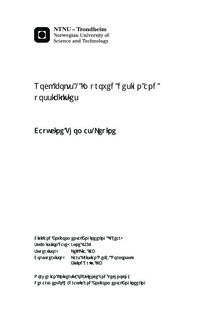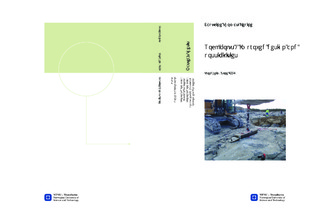| dc.description.abstract | SummaryRock Bolts, improved design and possibilitiesMaster thesis NTNU 2012Student : Capucine Thomas-LepineSupervisor : Leif LiaKey words : rock foundation, small concrete dam, rock mass classification, rock joints, shear strength of rock discontinuities, fully grouted passive rock bolts designMasters Thesis : Rock bolts, improved design and possibilities is a continuation from the Masters Thesis NTNU 2011 Rock bolts in dams, expected capacity by Lars Kristian Neby. Internationally, dam engineering focuses mainly on pre-stressed anchors in rehabilitation and improvement of stability of large dams, which is undergoing constant research in North America. Passive rock bolts are used in small concrete dam foundations to ensure sufficient stability against overturning moment from ice loads. This concerns the majority of dams in Norway, over 98% of whose electricity comes from hydropower developed over the last 100 years and still developing. Design is ruled by regulation from NVE (Norwegian water resources and energy directorate) published first in the 1980s, and regularly revised until the retroactive Retningslinjer for betongdammer in 2005. This design method for passive rock bolts is conservative with regards to rock capacity, as it is worldwide. The model, developed in the early age of rock bolt development in 1977 by Littlejohn and Bruce, considers the rock resistance as equivalent to the weight of the cone of rock around the bolt. Rock engineering has improved since, often with regards to underground engineering, which is not necessarily transposable to dam engineering. The inherent uncertainty in rock mass characterization slowed development of new design method for passive rock bolts. This is however of great interest in the Norwegian hydropower industry, and for applications to other civil engineering structural foundations. This thesis is meant to develop knowledge of qualitative and quantitative rock mechanisms in passive rock bolts in order to improve their design.The work is composed of three parts, as follows :A study on rock mass capacity and mechanisms in dam foundations, comes first. An empirical and quantitative estimation of rock mass strength with regards to recognized classification Q, RMR or GSI is proposed, based on Wyllie (1992) and results from Lars K. Neby. Full scale tests are then performed to the assess validity of empirical relationships developed in the first part between rock mass quality and rock bolt capacity (maximal tension load in pull out tests). 50 steel bolts with diameter 25mm and mortar grouted length 0.4m were pulled out with logging of strength and deformation in a rock quarry presenting various degrees of rock quality (RMR 40 to 80), representative of expected conditions for dam foundations. Rock quality was assessed for each bolt by laboratory testing (intact material properties) and rock mass characterization on site supplemented by core drilling or video inside hammer drilled holes. This program of tests was an improvement on the protocol developed and performed by Lars K. Neby on 18 bolts, whose results give the first relevant clues on parameters such as limit range of quality of rock (RMR>40), length of bolt (0.4m), maximal capacity (more than 20 tons, when conservative calculations assessed 0.2 tons). The results of testing confirm the relationships developed in a more statistical approach.Conclusions from these two parts lead to a proposition for a new design model, with a higher resistance contribution from the rock. The three modes of failure (rock, steel, grouting) are considered for ensuring resistance of a maximal stress of 180MPa (to avoid important deformations in the structure). Factors of safety and the range of validity in the rock mass condition for the proposed design are also considered. The thesis concludes with propositions for further works in order to :- Further extend the domain of validity of the proposed design.- Review methods of control of installed passive rock bolts.- Document and improve knowledge of load transfer mechanisms in passive rock bolts in dams. | nb_NO |

